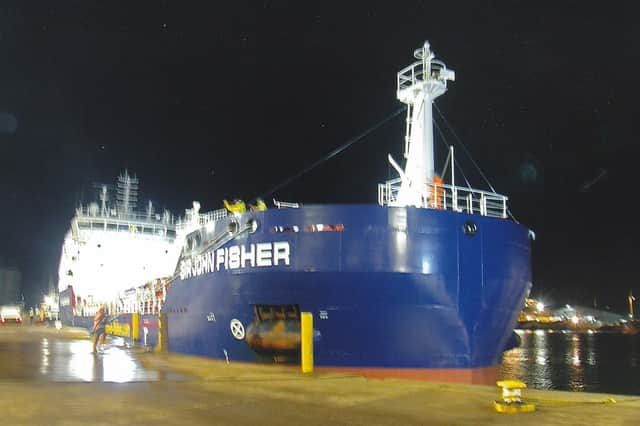Shipping Lines - A ship of the future, and a name from the 17th Century


SHIP OF THE FUTURE AND A NAME FROM THE PAST
From time to time loose ends require tidying up otherwise they tend to get overlooked and occasionally an interesting ship can get bypassed as could have been the case of the Lithuanian vessel Klaipeda-registered mini-bulker Afalina. Her home port has been noted a few times recently at Montrose.
Arriving from Invergordon with a part cargo of fertiliser she was slightly bigger than average for Montrose being 105 metres in length with a deadweight tonnage of 4,535 having been completed as the Aila by the long-established German shipyard of J. J. Sietas near Hamburg in 1989. Her cargo had originally been loaded at the Moroccan port of Jorf Lasfar. She back-loaded logs bound for the former East German port of Rostock.
Advertisement
Hide AdAdvertisement
Hide AdIn the summer of 1635 a shipyard was established by Carsten Sietas in the heart of a fruit growing district Altes Land near Hamburg. Nine generations were to follow, the company being family owned over all that time.
First vessels were built of wood but this changed to steel from the early 20th century. By 2009 the shipyard was facing financial difficulties due to steeply rising steel prices, a rapid fall in demand for container ships and the miscalculation of costs. The global recession led to the cancellation of orders with a bank taking control of the company’s business affairs, and moved out of family control for the first time since 1635.
Later, in 2014 it was taken over by the Pella group which had Russian connections and became known as Pella Sietas Werft. Further financial turbulence ensued and with the current political situation who knows what future, if any, lies ahead for the remnants of the company which is steeped in German shipbuilding history.
The future of ship propulsion was seen at Montrose overnight at the very beginning of March with the, albeit rather brief, call of the coastal tanker Sir John Fisher. Probably one of the largest tankers ever to berth at the port, with a deadweight of 6,106 tons and a length of 93 metres, she arrived from Immingham via Aberdeen.
Advertisement
Hide AdAdvertisement
Hide AdCompleted last November by China Merchants Jinling (CMSL) shipyard at Yangzhou, China she is one of a pair of hybrid-driven ships, the other being Lady Mary Fisher, completed last month and which carried a cargo of vegetable oil from Vietnam to the UK for processing into biodiesel fuel.
Owners, James Fisher Everard claim to have used four methods of ship propulsion in their 175 years in the shipping business – sail, steam, oil and now LNG. Painted along her hull were the words “PIONEERING SUSTAINABILITY”. The two new ships will replace some of the older vessels with the Galway Fisher having been sold on after 23 years of service.
The South Quay has seen numerous types of vessel since it was officially commissioned in April, 1975 and it’s not always big ships that catch attention as was proved recently with the arrival in February of the tug/workboat Voe Earl. Similar to the Isle of Jura she is a multi-purpose vessel, in some respects similar to a mini-lighthouse tender with the range of tasks she can perform. Described by her builders as a Multi-cat she was completed by the Damen group at Hardinxveld in The Netherlands.
Her on-board equipment allows her to tow, dredge, operate an rov, survey, provide dive support, etc. With a length of 24 metres she is driven by two Caterpillar engines and fitted with comfortable accommodation for eight persons. Incidentally, Isle of Jura was recently observed at the South Quay discharging two buoys shipped back from the Berwick Bank wind farm site.
To be concluded.
Caption: Ship of the future – Sir John Fisher at Montrose.